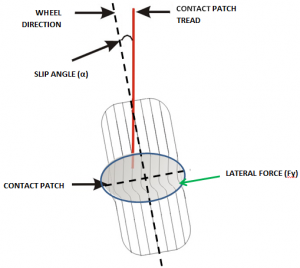

Posted: November 24, 2016 Read time: 8 Minute
If you want to get the maximum enjoyment and best times on your track days, a simple and effective place to start (outside of your own driving technique) is by focusing on your tyres.
More specifically – your tyre pressures. As you drive a circuit at speed, your tyres will increase in pressure. Increased cornering forces generate friction which in turn raises the tyre temperature and expands the air inside.
Heavy braking too will play its part as heat from the mechanical components around the wheel soak into the tyre.
So is the increase in pressure a positive or a negative when it comes to optimising your driving ability?
What do you need to take into consideration when setting your tyre pressures for a track day? Let’s take a look.
The key to answering these questions lies in the topic of Slip Angles. You’ll know, even from turning a corner at slow speed on an ordinary road that the weight of your body is pushed towards the outside of the turn. Had the mechanical grip of the tyres not changed the direction of travel you would have continued to move forward and this forward force or inertia is still being applied as you go around the corner. The result is a side or lateral force on the tyre where it comes into contact with the road distorting the shape of the tyre.

This distortion or flexing means that when cornering, the contact patch of the tyre and the wheel are pointing and travelling in a different direction to each other by a few degrees. The difference is known as the slip angle. As the cornering forces acting on the tyre build through a corner, the tyre will increasingly flex on the rim. It’s the difference in the travelling direction of the wheel and the tyre that generates friction and grip.
Choosing the correct tyre pressure is fundamental to maintaining the optimum contact patch on the road and tyre sidewall rigidity. There is a maximum amount of flex (Slip) a tyre will accept before it will no longer be able to support the weight of the cornering vehicle and the tyre will roll onto its side wall and start to slide.
A modern saloon car will generate in the region of 0.8g to 0.9g of grip between the tyre on the road, a modern supercar, however, can achieve a staggering 1.5g on its road tyres. With these levels of lateral forces, a typical road tyre pressure may not support the increased cornering forces and increased weight experienced by the tyre on circuit.
If you have arrived at a circuit on road tyres, however, you may find you can leave your tyres at road pressure – at least in the beginning. The subsequent high-speed laps will raise the pressure to a more suitable one for circuit driving. After your first 5 to 10 laps return to the pit lane and check the pressure. How much you run them over the standard manufacturers' pressure settings is largely down to the vehicle you drive and the tyres you use. As rule of thumb 4 to 6 PSI is a safe guide for road tyres. You will need to monitor the pressures throughout the day. If you are in any doubt, please seek advice from your tyre supplier or race shop.
If you have swapped your road tyres for track day tyres the advice is to set the pressure cold and monitor and adjust after your first short session. As a rule you will experience a 4 to 6 PSI differential between a cold and a hot tyre.
Always take a basic tool kit with you to track days which includes a tyre pressure gauge and tread depth indicator. If you are driving home on the tyres you arrived with, you need to make sure you have enough tread left at the end of the day to drive home legally. Remember, the legal minimum requirement for a tyre is 1.6mm across the central three-quarters of the breadth of the tread and around the entire circumference. Halfords Autocentre
Halfords Autocentre
We talked about understeer and oversteer in our last blog: going beyond the grip limit and you will find that subtle adjustments to tyre pressures will increase and reduce understeer and oversteer.
If you really want to take tyre pressure optimisation to the next level however, you may want to fill your tyres with Nitrogen. Compressed air contains water molecules and will affect the tyres ability to maintain a consistent pressure once heated. Dry Nitrogen offers a moisture free alternative offering lower tyre running temperatures and consistent pressure maintenance.
Call: 01234 757 633
Email: info@catdrivertraining.co.uk
CAT Driver Training is the fast way to develop & improve authentic dynamic driving skill, technique & knowledge from the Best. OEM recognised driver training for individuals & the motor industry. As the leading UK based independent advanced performance driving skills company, we exist to make your driving experience even better. Explore your cars potential, fulfill your own. Coaching advanced road & track skills, safety driver training courses for individual driving enthusiasts & advanced driving for all facets of the motor industry. The only training company resident within UTAC's Millbrook Proving Ground in Bedfordshire, within easy reach of London, & all surrounding counties: Hertfordshire; Buckinghamshire; Oxfordshire; Nottinghamshire; Cambridgeshire; Norfolk; Suffolk; Essex; & Surrey. Clients travel from the World over & the UK to learn from the authentic evidence based dynamic driving & vehicle dynamic experts. | All Rights Reserved | Copyright 2005 – 2025
Some of the links we use are affiliate links. This means that, at no cost to you, CAT will earn an affiliate commission if you click through the link and finalise a purchase.
Designed by WHP
Coded and built by Prominent Media